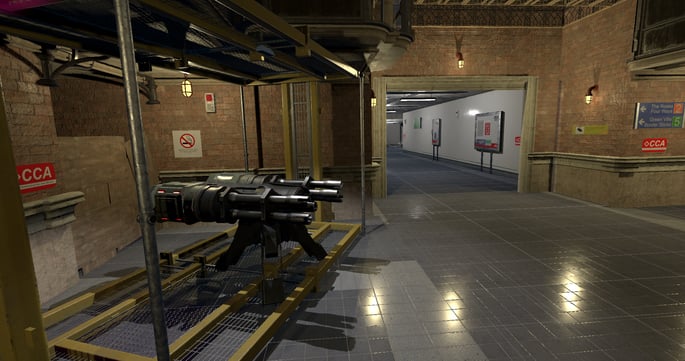Full Sail University - GDMS Project and Portfolio Updates
Details for research guiding updates made for portfolio and projects.
Terminus Station


In support of tying progression toward a game goal with indication and feedback, a fuel resource spent in activating generators powering tower defense turrets was tied to a game goal of spending sufficient fuel to power all defenses, lights and other electronics on the path to a subway train the player would escape on (Toth, 2025a). This was based on the concept of enhancing game feel through amplification elements like juicing, adding indication or feedback related to a player’s actions, creating event signifiers that improve player immersion and establish relationships between action and effect (Pichlmair & Johansen, 2022). In practice, this is achieved through having each fuel spent power the defense it is clearly tied to, but also a portion of the path to the exit, causing numerous forms of feedback and indication, including lights powering on, devices animating open or into position, indicators changing appearance or color to support the status, which are relating immediate actions to responsive effect and sense of affordance (Pichlmair & Johansen, 2022; Toth, 2025a).
CECO Ladder Mini-Games
Due to the intended audience for the series of mini-games being neurologically disabled students undergoing physical therapy, the games were intended to create encouraging, no-loss experiences (CelleC Games, n.d.). Preventing losses and adding effects on its own would not necessarily support this encouragement, especially with the students’ conditions, because effects applied carelessly may impede recognition of their underlying event or fail to create a meaningful relationship between feedback and action (CelleC Games, n.d.; Kao et al., 2024). Toward this end, the timing of effects in the mini-games was carefully managed and adjusted when they were unnecessarily distracting or unclear, such as in Ice Cream Stacker where the sound effects for shuffling were overlapping and felt unsatisfying, so the ice cream sprites were displayed with a staggered effect to allow for a sequencing of their visual appearance and audio effects (CelleC Games, n.d.; Kao et al, 2024).
Conquering of the Royal Keep
With a heavy focus on its narrative and because of its visual style, Conquering of the Royal Keep must place a high priority on the cohesiveness of its game goals, supporting script and clarity of available actions represented at any moment of gameplay (Black Banshee Studios, n.d.). This is reinforced by how a player’s ability to interpret affordance is not invariably consistent and can be altered by their motivation, or lack thereof and that it must feel consistent to the player’s understanding or expectations, as might be influenced by narrative or other elements of game feel (Bhatnagar et al., 2024; Lee, 2020). During the course of development, several puzzles in the game were determined to not have a clear relationship to their goals, significance to a narrative element or clear indication of their intent, as with the Torchlight Puzzle consisting of a series of rotating elements based on timing rather than direction or clear pattern, leading to a redesign of the puzzle to incorporate corresponding colors into the puzzle and its solutions, allowing easier understanding of the goal (Bhatnagar et al., 2024; Black Banshee Studios, n.d.; Lee, 2020).
References
Bhatnagar, P., Laattala, M., Dutta, S., & Hämäläinen, P. (2024). Understanding the design of emotionally
impactful game feel. Proceedings of the 2024 CHI PLAY Conference Companion (pp. 1–5).
https://doi.org/10.1145/3640723.3651284
Black Banshee Studios (n.d.). Conquering of the royal keep [Video game]. Black Banshee Studios.
CelleC Games (n.d.). CECO ladder mini-games [Video game]. Cellec Games.
https://cellecgames.itch.io/ceco-ladder
Kao, D., Ballou, N., Gerling, K. M., Breitsohl, H., & Deterding, S. (2024). How does juicy game feedback
motivate? Testing curiosity, competence, and effectance. Proceedings of the 2024 CHI Conference on
Human Factors in Computing Systems (pp. 1–15). https://doi.org/10.1145/3613904.3642656
Lee, J. (2020). Adaptive behavior in sandbox games: How motivation shapes use of affordances in virtual
worlds (48798) [Doctoral dissertation, Michigan State University]. MSU Libraries Digital Collections.
Pichlmair, M., & Johansen, M. (2022). Designing game feel: A survey. IEEE Transactions on Games, 14(2),
197–210. https://doi.org/10.1109/TG.2021.3072241
Toth, C. (2025a). Terminus station. Unpublished video game.